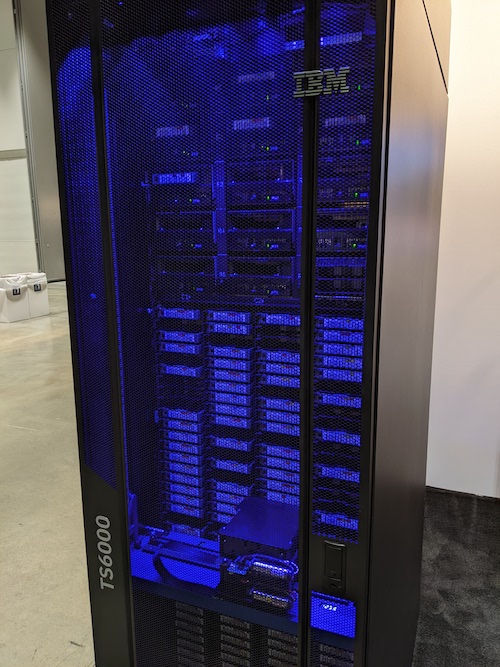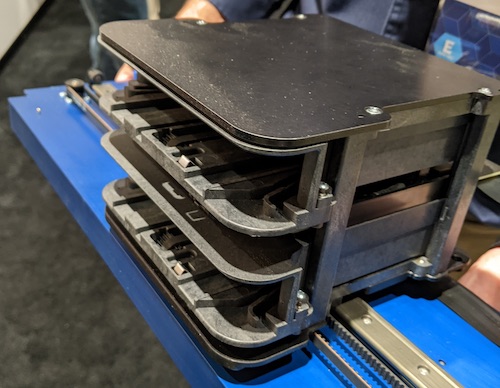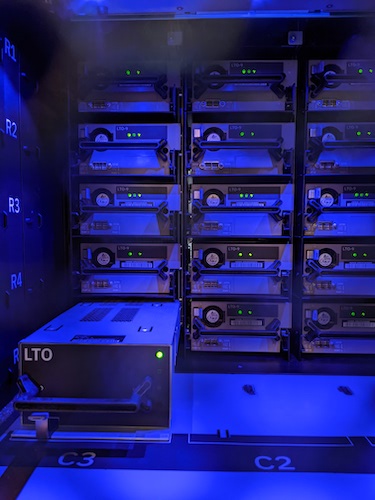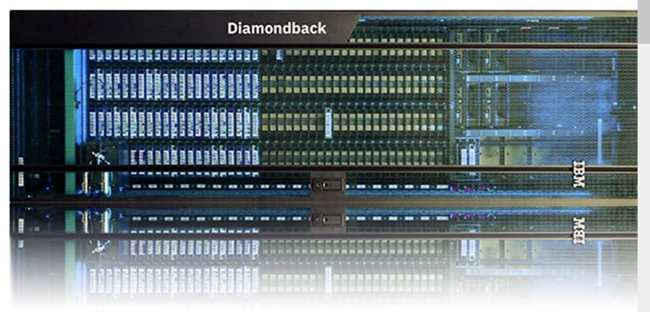IBM Diamondback Tape Library
Up to 69.5PB with LTO-9 in compressed mode
This is a Press Release edited by StorageNewsletter.com on October 27, 2022 at 2:02 pmIBM Corp. is extending its portfolio of data resilience solutions with the Diamondback tape library, a high-density archival storage solution that is physically air-gapped to help protect vs. ransomware and other cyber threats in hybrid cloud environments.
The Diamondback is for organizations needing to securely store hundreds of petabyte of data, both traditional and ‘new wave’ hyperscalers – global enterprises aggregating massive customer data sets. It provides long-term storage (27PB in an OCP-sized rack) with a smaller carbon footprint compared to flash or disk storage, and with a lower TCO.
“With data breaches and ransomware attacks now a constant threat, enterprises are increasingly turning to the data resilience provided by IBM Tape solutions,” said Scott Baker, VP and CMO, IBM Storage. “The IBM Diamondback Tape Library provides critical protection against a variety of threats, helping minimize data center floor space requirements and organizations’ carbon footprint. It’s part of the end-to-end data protection and security solution that IBM can deliver.”
“Driven by an explosion in data volume, ransomware, and increased regulatory and sustainability requirements, hyperscale cloud providers are among the biggest consumers of tape storage, and are predicted to drive tape capacity shipments to new levels in 2023,” said Phil Goodwin, research VP, IDC. “IBM’s Diamondback Tape Library is the company’s latest solution for both traditional and cloud hyperscale enterprises. It is designed to deliver on customers’ needs for scalability, sustainability and security with simplicity and self-service.”
Diamondback is designed to deliver 3 main benefits:
- Sustainability: It reduces power and cooling requirements, with a 97% lower carbon footprint vs. HD, as it sits idle in automated libraries consuming no energy until accessed. Its long-term endurance allows tape to store data for up to 30 years.
- Ransomware protection and cyber resiliency: Organizations WW are pressured to strengthen their defenses against malware and data breaches. Tape provides physically air-gapped isolation to increase resiliency against threats.
- Data capacity and storage costs: IBM tape is approximately one-quarter the total cost of HDD storage and public cloud archival services.
According to a recent IBM IBV study, 48% of CEOs responding across industries say increasing sustainability is one of the highest priorities for their organization in the next 2 to 3 years. However, 51% also cite sustainability as among their greatest challenges in that same timeframe.
The company’s sustainability strategy is driven by an approach that puts sustainability into action by advancing solutions that address climate change and support the transition to a low-carbon economy. As hyperscale cloud providers focus on reducing the environmental footprint of their facilities through lower power consumption, Diamondback is an ally in managing energy efficient infrastructures, built with the same security, scalability, and reliability that is the hallmark of IBM infrastructure.
The Diamondback provides cost-effective archival storage for the massive capacity demand of the zetabyte era, supporting vertical markets such as big data, analytics, cloud storage services, the IoT, healthcare, and life sciences. These organizations typically generate amounts of high-value unstructured data, much of which is stored as archives awaiting future reference, and can often benefit from an active archive implementation leveraging high capacity, low-cost tape systems.
The company recently announced the transition of Red Hat storage to IBM storage, helping deliver a consistent experience from edge-to-core-to-cloud. It also recently announced new cyber resilience products, including Spectrum Sentinel for SAP HANA and Spectrum Protect Plus Online Services for Salesforce. When combined with expanded Spectrum Archive support for direct access to file and directories stored on tape, these innovations demonstrate the firm’s position in the storage market.
The Diamondback tape library is available.
Resource:
IBM Tape Storage
Comments
IBM has chosen the OCP Summit in San Jose, CA - to announce their last tape library (TL), Diamondback model, a new generation dedicated to hyperscalers.
To give context, hyperscalers have special requirements that force them to design by themselves systems and other IT elements, the Open Compute Project, initiated by Facebook, illustrates perfectly this fact. These players have some challenges nobody have seen before especially on the data volume side and on the archive aspect of it.
Speaking about Facebook, they even launched in 2014 an optical project named Optical Archive Inc. led by Frank Frankovsky. This story hit a wall in 2015 as Sony swallowed this activity. More recently we heard that Sony has decided to stop ODA. But the optical story is not terminated as some players continue to believe and develop solutions. Folio Photonics has officially announced its optical media and we found others players like Kintronics in New-York, Zerras in California, leveraging Dacal Technology past work, or Digistore Solutions Holdings in Australian who promote some optical libraries, jukeboxes or 4U rack mount units.
And of course for long term archive we have to mention also others research projects around holographics, DNA, glass and of course tape. Apple acquired in 2018 Akonia Holographics who himself has bought InPhase assets in 2012. Long story short, it turns out that something is happening in these areas as well.

Back to IBM, that TL at the show was impressive in a dense OCP rack. As said above, pressure are on vendors shoulders, and IBM, a serious player in the domain with Quantum and Spectra Logic, had to react and release something. They did it and specs are significant: 14 LTO-9 tape drives with 1,548 tapes for a total raw capacity of 27PB on 8 square feet. With LTO-9 compression enabled and a ratio of 2.5:1, the capacity reaches 69.5PB.
Quantum has already built and demonstrated a real business line with hyperscalers, they developed a specific modular TL named Scalar i6H. Spectra Logic has also a modular model with the Stack and TFinity ExaScale for hyper capacity.
Beyond the density, IBM, like Quantum, designed a library with independent frame, each rack is autonomous and is not linked to others for robotics circulation or movements… Tapes belong to a frame and stay in the frame and have to be read and write by local tape drives.
Both approaches leverages erasure coding with RAIT (Redundant Array of Independent Tapes) and RAIL (Redundant Array of Independent Libraries) to span TLs potentially and augment durability and throughput. Of course mirroring across libraries could be used being one of the level possible. In that case, you obtain redundancy between TLs and within each of them with EC implemented with RAIT. This is achieved by external logic coupling media and volume management and I/O processing that can be fully controlled by hyperscalers. IBM told us at the show that some extension to Ceph will be made and module from HPSS for RAIT aspects will be used as well. A second product iteration is planned for early 2023 with additional functionalities like logical library creation or an extended GUI among others. Another good thing with the product is its time to deploy, it requires only 30mn. The product is GA since the announcement October 20.
Like Quantum and Spectra Logic, Big Blue plans to offer this model to enterprises.

The model exposed at the show has TS6000 written on it (see photo above), and the team told us that Diamondback is not a code name but the real name of the product. Let’s admit it but the Diamondback FAQ mentioned the TS6000 name as well with the TS3500/4500 code names Anacondas.

For some readers who had some doubt, tape continue to demonstrate its fit for long term data storage as it is passive by nature thus is green with the very limited cooling and power requirements and providing natural air gap, high capacity and long term capabilities. And you can even see Diamonback working with a short video if you follow this link.
It confirms once again that secondary storage is a gold mine, next months will be fascinating to see.














 Subscribe to our free daily newsletter
Subscribe to our free daily newsletter


